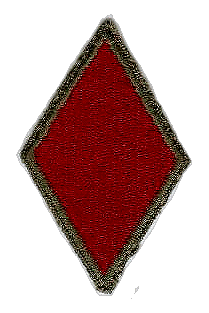Yves J. Bellanger

THE 5TH INFANTRY DIVISION
"RED DIAMOND"

 NORMANDY BEACHHEAD
Rain was sacking into County Down,
North Ireland, as usual, on the 2nd of July, 1944, when the majority
of Red Diamond troops were informed that they were "sealed
off" from the civilians and restricted to camp and billet,
under secret departure orders. And it was raining, as usual, as
the division converged on the harbor at Belfast by train and truck
and embarked, on personnel and motor transports for an unknown
shore. For division veterans, it was the fourth time in three
years they had boarded gangplanks to shout their first names and
serial numbers to answer to the call of their last names from
passenger lists. They had boarded at Brooklyn of Boston for Iceland,
at Reykjavik for England, at Cardiff for North Ireland in previous
gangplanking. But this time they told each other "this is
it, I may have gotten on a ship before but this time I get off
on the battleground.
NORMANDY BEACHHEAD
Rain was sacking into County Down,
North Ireland, as usual, on the 2nd of July, 1944, when the majority
of Red Diamond troops were informed that they were "sealed
off" from the civilians and restricted to camp and billet,
under secret departure orders. And it was raining, as usual, as
the division converged on the harbor at Belfast by train and truck
and embarked, on personnel and motor transports for an unknown
shore. For division veterans, it was the fourth time in three
years they had boarded gangplanks to shout their first names and
serial numbers to answer to the call of their last names from
passenger lists. They had boarded at Brooklyn of Boston for Iceland,
at Reykjavik for England, at Cardiff for North Ireland in previous
gangplanking. But this time they told each other "this is
it, I may have gotten on a ship before but this time I get off
on the battleground.
This is it.
It was. The division transports joined
a large convoy that moved slowly southward through the Irish sea
into the English Channel and to the coast of France, at Ste Mere
Eglise. The beachhead had been won 33 days before, on June 6,
and its price was reflected in the hulk of shipping that littered
the approach to the beach. A fine mist filled the air the late
afternoon of 9 July as troops clambered down the side of transports
by cargo nets into Landing Craft, Tanks and Landing Craft Vehicles,
personnel dressed in full field equipment, plus duffel bag. A
very few troops waded ashore through two and three foot deep water
from landing craft but the rest were disgorged from craft onto
a steel ramp that fingered a hundred yards out to sea from the
shore, and then walked ashore with full field and duffel bag.
Troops hit the dune line of Utah Sugar Red Beach, dropped duffel
bags and walked five miles to Transit Area B that night, starting
out at daylight again to march early twenty miles to the division
concentration area near Montebourg. The first impression of France
was that it was hot, and full of shall-shattered towns, dead cows
and signs everywhere that said "mines cleared to hedges"
or "mines cleared to edge of road". A heavy, fetid smell
was in the air, artillery rumble in the distance, planes were
overhead constantly and it didn't take long for everyone to get
the idea, neverthereafter forgotten, that a clean rifle and a
good foxhole were the most important thing to see to before bivouacking
for the night.
On landing, the division had been assigned
to First Army and on the 11th was further assigned to V Corps.
Orders were received 12 July for the 5th Division to relieve the
veteran 1st Division in the lines in the Caumont sector. Relief,
part of which was performed under artillery shelling by the Germans,
was accomplished by 1500 hours 14 July.
Caumont was the southernmost salient
of the beachhead and the left flank of the First Army. The British
11th Armored Division was on the left and the 2nd Infantry Division
on the right. Caumont was a ten-day period of battle inoculation
against the roughest outfits in the German army, the 3rd and 5th
Parachute Divisions. Shelling was constant by both sides, as was
patrolling activity. The remnants of the German air force also
made nightly reconnaissances and bombings and strafings. On the
left the British and the Germans were engaged in a terrific battle
for Caen, with incessant artillery duels that kept the night times
constantly aglow. On the right, the 2nd Infantry Division was
slugging toe to toe with the Whermacht for St Lo.
Caumont was typical hedgerow country.
Tall hedgerows and trees bordered small fields and there were
many sunken roads which provided covered approaches under artillery
fire but turned into mudholes when it rained.
On 23 July, the British took over the
Caumont sector, the 15th Scottish Infantry Division relieving
the 5th. After which the division, less the 2nd Infantry Combat
Team and Division Artillery and attachments, moved to an assembly
area, in vicinity of Cerisy la Foret. The 2nd Combat Team, supported
by a fire support group from the 10th Infantry remained in position
preparing for an attack to straighten out the first Army's line.
Thus the men of the 2nd Infantry saw the toughest hedgerow fighting
in the beachhead of the division troops.
Pages 5 and 6 of the History booklet
of the 5th Infantry Division, published at Metz, France, in December
1944.
Thanks to Lester Cormicle for his
help in the transcription of the booklet.
The story continues in Normandy
page.
The Battle
of Vidouville
Home

 Back
Back
 All rights reserved, Yves J. Bellanger
Created in July 2001
Updated July 16, 2001 by Yves
J. Bellanger
All rights reserved, Yves J. Bellanger
Created in July 2001
Updated July 16, 2001 by Yves
J. Bellanger

